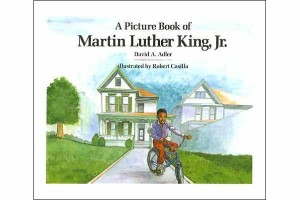News & Calendar:
- Log your reading days before Monday: RTSUtah.com.
- Don’t forget to do great at logging reading, work on reading fluency and comprehension goals, and behave well in class so that you can earn time at “Win-it-in-a-Minute” this year!
- Our DIBELS end of year test is 2 weeks away: Monday, May 18th. If for some reason you won’t be at school that day, let us know ASAP so that we can have you do your assessment the week before.
- We are working on a Mother’s Day surprise this week! Look for it to come home in the backpack on Friday.
Main Objectives for this week:
Students will be able to…
… read and comprehend this week’s selection, “A Picture Book of Martin Luther King, Jr.,” focusing on the strategy “Adjusting Reading Speed.”
… learn and use these new vocabulary words: demanding, fair, laws, graduated, arrested, prejudice, content, and section.
… review inflectional endings, the comparative ending –er, irregular plurals, and suffixes –er and -ness.
… review singular vs. plural nouns, common vs. proper nouns, capitalization, adjectives, and articles.
… read and retell the decodable story #47: “Little Italy in New York.”
Objectives from our “Imagine It!” Program:
Reading Informational Text:
I can describe key details in an informational text using the questions who, what, when, where, why and how.
I can identify the main idea and details that support it in informational text.
I can identify the main topic and supporting details in text.
I can use strategies to figure out the meaning of words and phrases.
I can comprehend informational text by clarifying, summarizing and asking/answering questions while I read.
Reading Foundational Skills:
I can read the suffixes –er and –ness independently and behind base/root words.
I can read words with inflectional endings and the comparative ending –er independently and behind base/root words.
I can identify the purpose of informational text and check my understanding while I read.
I can read text with purpose and understanding.
I can fluently read on-level text focusing on pace.
Writing:
I can write a narrative using the writing process.
I can improve my writing by revising and editing spelling, punctuation, and grammar.
I can make conjectures (predictions) for my inquiry question and record them in my writer’s notebook.
Speaking and Listening:
I can follow rules for participating in discussions including listening, asking appropriate questions, building upon others comments, and staying on topic.
I can remember and tell others the important details that I have heard or read.
I can tell a story or recount an experience with relevant facts and details.
Language:
I can follow spelling rules and patterns for three-letter consonant blends.
I can figure out the meaning of a word by knowing the meaning of parts of the word.
I can use context, affixes, root words, or compound words to clarify the meaning of unknown words.
I can discover and use new words and phrases acquired through reading, listening, and conversation.
Spelling
- scrape
- straw
- split
- splash
- screen
- sprout
- scratch
- sprawl
- scream
- stripe
- spry
- stretch
- strength
- strange
- splendid
Spelling Homework this week: .
Monday– “Copy 3x”= copy the words you missed on the pretest 3 times
Tuesday-Wednesday– Choose any two:
“ABC Order”= list the spelling words in ABC order
“Syllables”= sort your words by how many syllables are in the words. For words that have more than one, place a large dot or slash in between each syllable, such as “ba/sic”
“Quiz”= have a partner quiz you on the words
Thursday– Test!
Common Core Standards we are focusing on that match this week’s objectives:
RI 2.1: Ask and answer such questions as who, what, where, when, why, and how to demonstrate understanding of key details in a text. (T206-T208, T236)
RI 2.2: Identify the main topic of a multiparagraph text as well as the focus of specific paragraphs within the text. (T232, T234, T244, T246)
RI 2.4: Determine the meaning of words and phrases in a text relevant to a grade 2 topic or subject area. (T200-T201, T221)
RI 2.10: By the end of year, read and comprehend informational texts, including history/social studies, science, and technical texts, in the grades 2-3 text complexity band proficiently, with scaffolding as needed at the high end of the range. (T206-Y209, T218-T221)
RF 2.3.b: Decode words with common prefixes and suffixes. (T230-T231)
RF 2.4.a: Read on-level text with purpose and understanding. (T199, T247)
RF 2.4.b: Read on-level text orally with accuracy, appropriate rate, and expression on successive readings. (T223)
W 2.5: With guidance and support from adults and peers, focus on a topic and strengthen writing as needed by revising and editing. (T252-T253)
W 2.7: Participate in shared research and writing projects (e.g., read a number of books on a single topic to produce a report; record science observations). (T210-T211)
SL 2.1.b: Build on others’ talk in conversations by linking their comments to the remarks of others. (T222)
SL 2.2: Recount or describe key ideas or details from a text read aloud or information presented orally or through other media. (T222)
SL 2.2: Recount or describe key ideas or details from a text read aloud or information presented orally or through other media. (T222)
L 2.2.d: Generalize learned spelling patterns when writing words (e.g., cage – badge; boy – boil). (T239)
L 2.4.b: Determine the meaning of the new word formed when a known prefix is added to a known word (e.g., happy/unhappy, tell/retell). (T230-T231)
L 2.6: Use words and phrases acquired through conversations, reading and being read to, and responding to texts, including using adjectives and adverbs to describe (e.g., When other kids are happy that makes me happy.) (T222, T224-T225)
Mystery Question!
Your student will receive a Skyhawk HERO Ticket if he or she can answer the “Mystery Question” in his or her planner or on a piece of paper sometime before Friday:
Which test is coming up in 2 more weeks?
